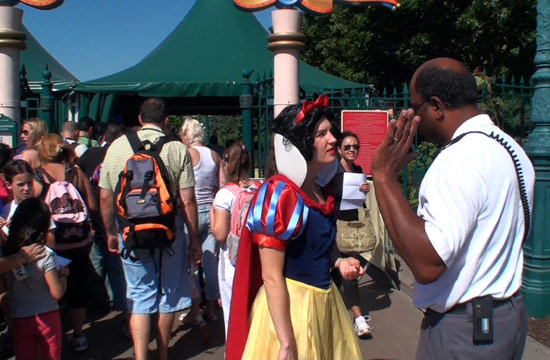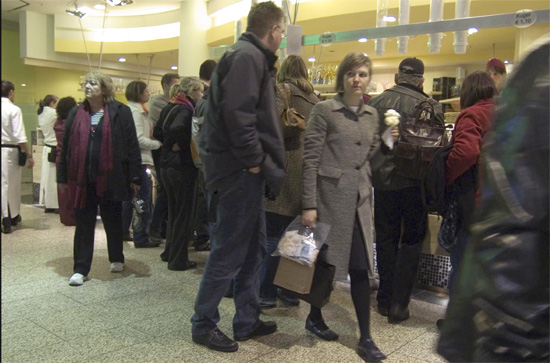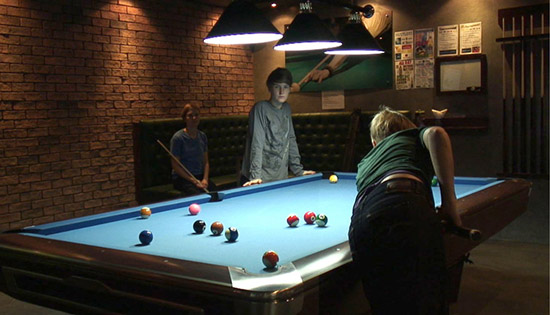An instigator of the social norm, Pilvi Takala’s artistic practice provokes many hidden questions dealing with societies and communities, and she does so with such nonchalance that almost matches with her innocence. Pilvi is definitely careful and clever in carrying out her performance acts. This past Summer, Pilvi and I had a nice conversation about her recent project Real Snow White, her feelings about the iconic Disneyland, and what irks her about malls. Her solo exhibition at the Finnish Norwegian Culture Institute in Oslo opens on November 18, 2010. Pilvi Takala is a performance and video artist based in Amsterdam.
When did you start doing these live performance acts?
In 2004 I went to Glasgow for an exchange from my school in Helsinki, at that time I was more interested in art in the public space and not so much showing in galleries. There I made the first piece that was kind of meaningful. It’s an artist book based on a performative intervention called Event on Garnethill.
It’s really exciting to see your work. When I first saw your video, it was a two-day screening at Apexart. They weren’t all good, obviously, but I was so surprised by your piece. By what you did!
I don’t think it’s possible that I am the first adult who tries to get in to Disneyland dressed as Snow White or as another character. I can’t believe that could be the case, but as far as I know nobody else filmed it and made it into an art piece. It’s a kind of obvious thing to do when you go to Disneyland. Most of the kids are dressed in costumes bought in Disneyland, but there seems to be an age limit to entering the park in a costume.
So when did this idea to be dressed up as the “Real Snow White” come up?
I was in Paris for a couple of months in the summer 2009 and I hadn’t been to Disneyland before. I almost went when visiting California a couple of years ago, but in Paris I finally had to go because I also though I might want to make work there. Before I have been making work in places like shopping malls, that are somehow seem public but are actually private and very controlled. Disneyland is really the ultimate example of control. The success of the park is based on how perfectly controlled everything is and Walt Disney also had very interesting ideas about how to organize society. He intended to build a real community in Florida called Experimental Prototype Community of Tomorrow, but he passed away before finishing and now it’s just another theme park. It’s quite scary actually how well the parks work with so many visitors obeying all the rules and it’s even scarier to think how Walt Disney’s prototype for a real living community would be. He thought it’s impossible to fix the problems of the society, but it is possible to build a perfect community on empty land and have that as an example for the rest of the world.
There are so many Disneylands around the world, If you go to a different Disneyland, would you do the same performance?
I think the results would be more or less similar. They won’t let me in with that costume in any Disneyland. There can only be one Snow White at the time, and the girls who play her are all the same height and they all learn the same autograph. So if a kid goes to her twice s/he wouldn’t notice that it’s a different person. There’s no mistakes or things out of control in Disneyland, that’s very essential to the function of the park. I also think that in any Disneyland people would want a photo with me, whether I’m the Real Snow White or not.
In Paris there was one mother who was totally into the logic of the Real Snow White, she explained to me that I can’t enter the park because only the Real Snow White is allowed to dress like this and that her daughter thought I’m the Real Snow White. That was really funny, because I thought most people wouldn’t care as long as I looked good enough.
Isn’t that interesting how we’re shaped by all these ideals that we’re all brought up to believe in.
Yes, certainly. I was a bit surprised by kids asking for autographs and I didn’t know if the Snow White in Paris writes her autograph in English or French. I wasn’t sure about French so I wrote in English, I hope I didn’t disappoint anybody. I couldn’t see Snow White at all when I visited Disneyland before the performance, so I didn’t know how her autograph looks like.
Initially, I thought this project was a comment on American culture.
Well, it could be about American culture because that’s where the idea of the park comes from, but Disneyland seems to be a success everywhere, so we all like the idea. I know about American culture mostly from TV so I’m not an expert, I only visited there a couple of times. My main interest was in how the space is controlled and how people behave there, it’s amazing. After paying for the entrance or for a full week in a Disney Hotel, people expect the best time ever and are happy to play by the rules to get that. Maybe the rest of us learned this from Americans. As a consumer you are much more likely to accept all kinds of rules without thinking twice than as a citizen. There’s a nice text by two criminologists Shearing and Stenning called “From Panopticon to Disney World: the Development of Discipline.” They say Disney has basically managed to construct a fully functioning police state without any of its typical problems. So there’s a lot to be learned about successful crowd control.
Well, I went to Disney when I was 15 with some friends. I could tell you that it’s a strange experience and I felt out of place even then.
I wish I went there earlier but now I’m too old to fully appreciate the experience.
That was my next question: did you go to Disney when you were a kid?
No. Just to some park in Finland but they’re nothing like Disneyland. It’s not similar at all. But I have a friend who went when she was 12, and she thought it was weird and that she might be too old for Disneyland already. So she was quite young, but thinking there’s something wrong with the place. I have respect for how well everything is made and planned and I can still enjoy that, but I would have loved it as a child. The Paris park is quite small, so it would be nice to visit the huge one in Florida, although I would probably feel like leaving before seeing even half of it.
Disneyland is an extreme example of observing people’s behavior in a controlled public space. And people are ’supposed’ to have a good time.
People do have good time, and they even go back the next year. So the magic works and it’s great to leave your critical mind behind and enter the magic kingdom.
Do most of your projects deal with public space?
Yeah, but often the space is not really public, kind of semi-public and the focus is in the unwritten rules that govern the place or situation.
Tell me about the Bag Lady project.
It’s a week-long performance that I did first in 2006 in Berlin, in a mall at Potsdamer Platz. I was dressed neatly and went to hang out, shop and have coffee at the mall carrying a lot of cash in a transparent plastic bag. I just had somebody to follow me to observe the reactions from another angle during the performance and later I took some pictures and made an artist book, that is a kind of diary of what happened during the week. In 2008 I repeated the performance in another mall in Berlin as a part of Berlin Biennial and this time the performance was announced. I got the idea initially, because I had to spend some time in this mall in Berlin just to keep warm and I started to think about why I dislike malls so much.
There’s something so boring about the pleasant shopping environment and it seems like anything interesting is shut out by default. I wanted to perform a character that is a perfect customer, but also a perceived security threat. Someone who should be protected and served by the staff, but also a problem that has to be dealt with somehow. I behaved as normal as possible, I bought things but didn’t shop like crazy. It’s funny how the cash in the plastic bag seems like something so risky and dangerous, although the truth is that that is the last thing a pickpocket would touch in a mall. There’s cameras everywhere and everybody’s attention is with the cash, so that’s really the last thing that would get stolen. Still this bag of money manages to make the staff nervous and because it seems to make the place unsafe, but it’s hard for them to decide what to do about it, so they mostly tried to ignore it first. I wanted to see what they would do about it so I kept returning to the same shops.
What did you study in university?
Fine art. I went to the Finnish Academy of Fine Art in Helsinki, it’s a small university where you only study Fine Art. They have departments for painting, sculpture, printmaking, and then this department called “time and space” for everything else, where I went. There’s a good tradition of video art since the 80s and that was what I wanted to make when I started in the school.
How do you fund your projects?
The school I went to was free and they even had some funds for realizing projects. My work is generally quite cheap to realize. I got some grants from Finland and now I’m in the Rijksakademie residency for 2 years, which is funded mostly by Dutch government. I’m also sometimes paid to make specific projects. Both Finland and the Netherlands have good public funding for art, so selling work is not the only way to fund your practice.
If you have better funding, how would you use it?
First I would pay all my friends who help me and maybe get more professionals involved, but I can’t really bring a big film crew to my interventions anyway. I don’t think a bigger budget necessarily would make the work any better. I could use more expensive equipment, better microphones and really expensive spy cameras.
Who or what is your inspiration?
Since I started to do what I do now, I really liked artists like Sophie Calle, whose work blends with real life. I really liked Nikki S. Lee who goes into different communities, becomes one of them and takes snapshots of that. After seeing the work of Eija-Liisa Ahtila for the first time, I thought it’s really amazing and I wanted to make videos too. She’s the most well known video artist from Finland, she makes multi-screen installations and shoots on film. I should mention someone a bit younger than Sophie Calle.
I love Sophie Calle’s work.
She’s good, but it’s something from a while ago. I really like Jill Magid, she’s a bit younger and there’s an endless list of friends and people who make great work.
It takes a lot of guts to do what you’re doing, going against the stream of society, and the system.
That’s why I do it, it’s certainly exciting and fun. Doing the interventions is really what drives my practice, it’s really exciting to see how people react and take care of me or my character. If I knew what is going to happen it wouldn’t be worth doing. People often ask me how can I stay calm and don’t laugh in these situations, so I guess I have some kind of special skill to stay calm. I’m always playing a character, so it’s not me really doing something embarrassing. In my normal life, I’m not breaking any social rules, I’m behaving really well. I’m always polite and nice and do what is expected in certain situations. Otherwise I would be a real outcast. But I like breaking the rules as an exception, for the sake of research. I always prepare the interventions well, so I don’t really just start to behave weird in my normal life. It’s interesting to break rules, but to break them in interesting way is more complicated.
What’s the next project?
I actually finished something just now. It’s a video about my brother and his friends. He’s a professional poker player since 6 or 7 years, so I wanted to do something with that for a long time but really got started an year ago. So I just finally finished that I have some new things starting up.
You can see Real Snow White and other works on pilvitakala.com
All images courtesy of the artist.






 RSS
RSS
